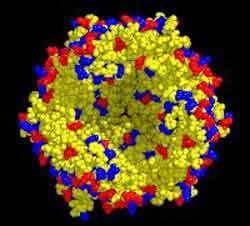Trojan Horses, xenon imaging and remote controlled genes

Trojan Horse ferritin
Chemical cages deliver drugs and peer into cells
As our understanding of biology increases, the tools of research become almost as important as the researchers wielding them. Currently, one of the major obstacles to research is actually getting inside of cells and tissue to see what is going on as it happens.
At the University of Pennsylvania, researchers are caging molecules – xenon, gene-blocking strands of antisense DNA and even therapeutics – to facilitate their entry into cells and enable researchers to observe nature’s biochemical clockwork.
Ivan Dmochowski, an assistant professor in Penn’s Department of Chemistry, details the methods that his lab is developing for the next generation of imaging, today at 9:30 a.m. at the American Chemical Society’s 228th National Meeting here.
“We are developing techniques to control and study biomolecules within cells and living systems,” Dmochowski said. “The most immediate payoff from this research will be in figuring out how proteins interact in real time inside living organisms as well as how diseases, especially cancer, progress through the body.”
Xenon-Enhanced Magnetic Resonance Imaging
While magnetic resonance imaging has already become a useful tool for research, Penn chemists hope to greatly extend the capabilities of MRI for monitoring multiple cancer markers simultaneously using the noble gas xenon as an imaging agent. By encapsulating a single atom of xenon within a cage made of cryptophane, it can become a sensitive reporter of changes outside the cage. When the cage is “rattled” by a specific cancer protein, for example, the xenon molecule will emit a telltale signal that can be tracked by MRI.
“Based on this principle, our lab is generating new biosensors that we hope will identify biomarkers associated with cancers of the lungs, brain and pancreas,” Dmochowski said. “Over time, we’ll be able to use MRI to detect aberrant proteins that cause cancer in humans before the actual formation of a tumor.”
“Trojan Horse” Proteins
Dmochowski and his colleagues are also exploring the use of ferritin, a large family of iron storage proteins that are integral to life, to smuggle items into cells. Since ferritin can move relatively easily into cells, the researchers are developing “greasy” ferritin-like cages that could be used for ferrying materials throughout the body. The protein cages have many interesting applications, including new agents for drug delivery, templates for forming metal nanoparticles and chemical probes for use in in vivo spectroscopic studies.
A Light Switch for Turning Off Genes
In order to understand the role of certain genes in embryonic development, the Dmochowski lab is studying how to use light to turn genes off. They have created caged antisense molecules – stretches of DNA that can clamp on top of working genes – that are released when their chemical cage is hit by ultraviolet or infrared light.
“By uncaging these molecules, our goal is to alter protein expression within a particular cell and at a particular time during development,” Dmochowski said. “It means that researchers could turn specific genes off like a switch in order to find out the nature of a gene by what happens when it does not work.”
Media Contact
More Information:
http://www.upenn.eduAll latest news from the category: Life Sciences and Chemistry
Articles and reports from the Life Sciences and chemistry area deal with applied and basic research into modern biology, chemistry and human medicine.
Valuable information can be found on a range of life sciences fields including bacteriology, biochemistry, bionics, bioinformatics, biophysics, biotechnology, genetics, geobotany, human biology, marine biology, microbiology, molecular biology, cellular biology, zoology, bioinorganic chemistry, microchemistry and environmental chemistry.
Newest articles

Bringing bio-inspired robots to life
Nebraska researcher Eric Markvicka gets NSF CAREER Award to pursue manufacture of novel materials for soft robotics and stretchable electronics. Engineers are increasingly eager to develop robots that mimic the…

Bella moths use poison to attract mates
Scientists are closer to finding out how. Pyrrolizidine alkaloids are as bitter and toxic as they are hard to pronounce. They’re produced by several different types of plants and are…

AI tool creates ‘synthetic’ images of cells
…for enhanced microscopy analysis. Observing individual cells through microscopes can reveal a range of important cell biological phenomena that frequently play a role in human diseases, but the process of…





















